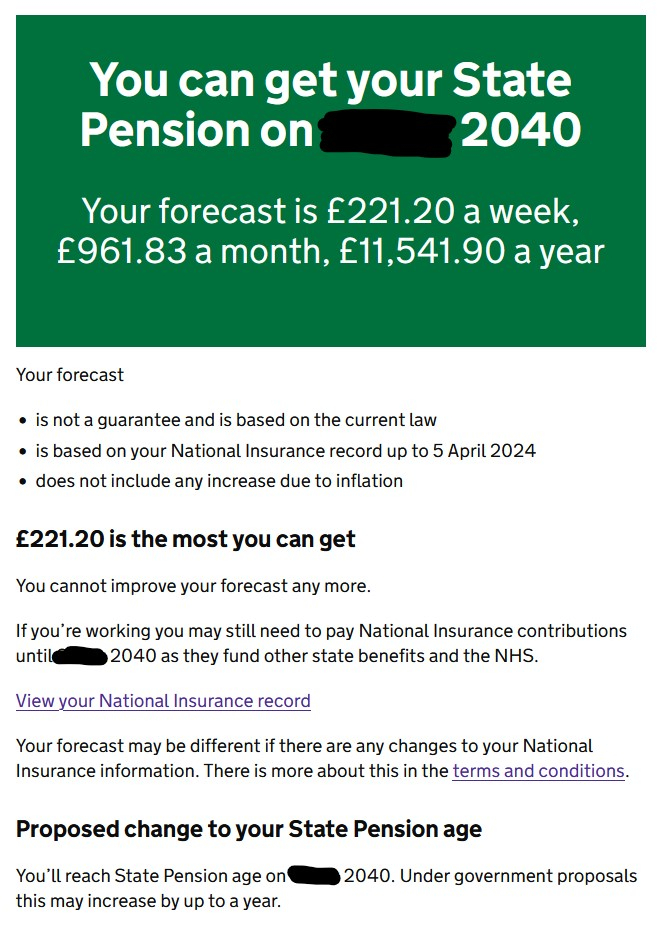
We’d like to remind Forumites to please avoid political debate on the Forum.
This is to keep it a safe and useful space for MoneySaving discussions. Threads that are – or become – political in nature may be removed in line with the Forum’s rules. Thank you for your understanding.
📨 Have you signed up to the Forum's new Email Digest yet? Get a selection of trending threads sent straight to your inbox daily, weekly or monthly!
State Pension forecast anomaly

M4rtyman
Posts: 37 Forumite





Something is confusing me, and I'm hoping someone here could maybe point out where I might be missing the obvious ...
I am in my early 50s, and currently have 33 full years on my NI record. And as far as I know, you have to pay in for 35 years before you get the full state pension. However, according to my state pension forecast (below), I have the full entitlement already and don't need to pay any more.

I am in my early 50s, and currently have 33 full years on my NI record. And as far as I know, you have to pay in for 35 years before you get the full state pension. However, according to my state pension forecast (below), I have the full entitlement already and don't need to pay any more.

I did IT contract work for a few years, using an Umbrella company, so paid a fair whack in EMPLOYERS NI. Would THAT be a factor?
I'm currently not working, kind of semi-retired, and if it became a problem, I know I only need to gain/buy another two years. I'm just kinda confused as to why they are saying I have hit the max already, with only 33 full years? 😏
0
Comments
-
35 years is only relevant to those born this century. Everyone with a pre 2016 history is on a hybrid scheme that, depending on personal circumstances, can take anything (anecdotally from reports on here) between 28 and 48 years to reach the full pension. The reason for the lower number of years required was that pre 2016 you had sufficient S2P to make your 2016 foundation amount greater than the equivalent years new pension amount.1
-
35 years is indeed required for the full new state pension.
However, qualifying NI years earned before the new state pension was introduced in 2016 gives you a "starting amount", which I think was based on how much old state pension you would have earned, so it is indeed possible to get your 35 years before actually working 35 years depending on how many of these years were earned before 2016.
• The rich buy assets.
• The poor only have expenses.
• The middle class buy liabilities they think are assets.0 -
It's because you haven't understood the new State Pension rules correctly. You are assuming the rules which apply to those people building up an NI record from 2016 apply to you as well. They don't.M4rtyman said:Something is confusing me, and I'm hoping someone here could maybe point out where I might be missing the obvious ...
I am in my early 50s, and currently have 33 full years on my NI record. And as far as I know, you have to pay in for 35 years before you get the full state pension. However, according to my state pension forecast (below), I have the full entitlement already and don't need to pay any more. I did IT contract work for a few years, using an Umbrella company, so paid a fair whack in EMPLOYERS NI. Would THAT be a factor?I'm currently not working, kind of semi-retired, and if it became a problem, I know I only need to gain/buy another two years. I'm just kinda confused as to why they are saying I have hit the max already, with only 33 full years? 😏
I did IT contract work for a few years, using an Umbrella company, so paid a fair whack in EMPLOYERS NI. Would THAT be a factor?I'm currently not working, kind of semi-retired, and if it became a problem, I know I only need to gain/buy another two years. I'm just kinda confused as to why they are saying I have hit the max already, with only 33 full years? 😏
0 -
molerat said:35 years is only relevant to those born this century. Everyone with a pre 2016 history is on a hybrid scheme that, depending on personal circumstances, can take anything (anecdotally from reports on here) between 28 and 48 years to reach the full pension. The reason for the lower number of years required was that pre 2016 you had sufficient S2P to make your 2016 foundation amount greater than the equivalent years new pension amount.I had been IT contracting from 2012 to 2020, and was paid quite well, so managed to build up a nice nest egg. By April 2016 I had been doing it for four years and had 27 years full NI Contributions.So it looks like what you are saying, is that by earning that bit more over those four years, it contributed to the S2P element of my pre-2016 contributions and reduced the 35yr requirement?
0 -
I have been an employee since 1998, had breaks for maternity leave (whilst remaining employed and claiming child benefit) and I have the same message as you. And will be 50 this year!
My health isn't great and I don't know for how many more years I'll be able to work so I'm just happy that at least this is sorted:eek::eek::eek: LBM 11/05/2010 - WE DID IT - DMP of £62000 paid off in 7 years:jDFD April20170 -
For most people in full time work, the single tier state pension of 2016+ both accrues and caps out at a lower level than the previous system did if you weren't 'contracted out' (e.g. weren't a member of a final salary scheme, or didn't individually contract out before that was abolished). Ergo when a previously always contracted in person had their 'starting amount' in the 2016 state pension calculated, pre-16 years would convert to more post-16 years.M4rtyman said:molerat said:35 years is only relevant to those born this century. Everyone with a pre 2016 history is on a hybrid scheme that, depending on personal circumstances, can take anything (anecdotally from reports on here) between 28 and 48 years to reach the full pension. The reason for the lower number of years required was that pre 2016 you had sufficient S2P to make your 2016 foundation amount greater than the equivalent years new pension amount.I had been IT contracting from 2012 to 2020, and was paid quite well, so managed to build up a nice nest egg. By April 2016 I had been doing it for four years and had 27 years full NI Contributions.So it looks like what you are saying, is that by earning that bit more over those four years, it contributed to the S2P element of my pre-2016 contributions and reduced the 35yr requirement?
For a formally contracted in person with many working years ahead, that was a bad thing because the state pension they would now accrue was smaller than what it would have been, had the old system continued...
1 -
I've been through this myself. In my experience the only person who understood it for a long time was Steve Webb, the former pensions' minister although I remember Martin Lewis picking it up last year.
My recollection is that the forecast you have is based on the assumption that you continue to pay each year national insurance until you retire at 2040. (I may be wrong about this so double check).
This misled me as I had stopped working but I did pay in additional voluntary contributions and retired with a full pension last year. It took a lot of effort - hours on the phone - but you have plenty of time to sort it out.1 -
As per the above replies, the 35 year "target" only applies to those whose NI record starts after April 2016, which is typically those born after April 2000.Employers NI is just a tax on a salary paid by an employer. It goes into the NI fund but doesn't buy any benefit for the employee.0
-
Freeheeler said:I've been through this myself. In my experience the only person who understood it for a long time was Steve Webb, the former pensions' minister although I remember Martin Lewis picking it up last year.
My recollection is that the forecast you have is based on the assumption that you continue to pay each year national insurance until you retire at 2040. (I may be wrong about this so double check).
This misled me as I had stopped working but I did pay in additional voluntary contributions and retired with a full pension last year. It took a lot of effort - hours on the phone - but you have plenty of time to sort it out.It was well understood by many of us on here as far back as the inception of the new pension in 2016, we were in fact giving more accurate information than DWP in the early years. The problem was that people stopped looking once they saw the big green box at the top.Your second paragraph is not quite correct. That figure is the amount you could achieve by the time you reach retirement, the text below clarifies what you need to do that be it nothing or pay in for x more years and a further paragraph if you need to fill past years. There is nothing misleading about the forecast, just people misunderstanding it.
6 -
You are quite correct about stopping at the big green box. I am sure this is standard behaviour which could be taken into account when designing a webpage to encourage people to read on. My misunderstanding (laziness, haste) misled me.1
Confirm your email address to Create Threads and Reply

Categories
- All Categories
- 352.7K Banking & Borrowing
- 253.8K Reduce Debt & Boost Income
- 454.6K Spending & Discounts
- 245.8K Work, Benefits & Business
- 601.9K Mortgages, Homes & Bills
- 177.7K Life & Family
- 259.7K Travel & Transport
- 1.5M Hobbies & Leisure
- 16K Discuss & Feedback
- 37.7K Read-Only Boards







